
Royal Navy Provisioning Locations Menu: 1 2 3 4 Next>>
Golden Age of Piracy Provisioning Locations - Royal Navy Page 2
England's Naval Victualling Stations, Continued
Victualling at Portsmouth
Portsmouth is the oldest English navy dock on this list. Around 275 A.D., the Romans built a fortress at the top end of the harbor, most likely to protect existing trade that was taking place within the natural harbor.

Artist: After George Vertue
King Richard I, Player Cigarettes Card (1935)
When Roman Britain collapsed around 410, the fort fell into disrepair.1 Still, the harbor was an appealing and easier to defend than many other portside locations. Alfred the Great, King of the West Saxons, is said to have put some of his fleet here and may have even ships built in Portsmouth Harbor in the late 10th century.2 However, the land "was sparsely inhabited in the eleventh century, for in 1086 there were only a few villeins [feudal tenants], bordars [people holding enough land to feed their family who were required to work for a manor lord on specified days], and serfs on the demesne lands of the manors of Buckland, Copnor, and Fratton, while the town of Portsmouth did not then exist."3 First Norman King of England, William the Conquerer, is said to have sailed out of Portsmouth Harbor in 1086 for Normandy France.4
The city first began to develop in the south-western corner of the island around 1180. It was founded by lord Jean de Gisors following his purchase of Buckland Manor from the de Port family.5 King Richard I landed there in 1189 when Southampton was in control of the harbour.6 Richard gave a royal charter to Portsmouth on May 2, 1194, "granting to the burgesses of Portsmouth an annual fair for 15 days at the feast of St Peter ad Vincula (i.e. 1 August), a weekly market on Thursdays, and quittance from toll, pontage [toll to repair buildings and bridges], passage, pedage [toll on passengers], payage, stallage [tax on market stalls] and tallage [other taxes] (as well as other liberties)."7
As a result, Portmouth became a hub for buying and selling goods, where wheat, wine, wax and other goods were imported into England from overseas.8 The first Royal Dockyards were mentioned in an edict by King John in 1212, who ordered "our Docks at Portsmouth to be enclosed with a Good and Strong Wall ...for the preservation of our Ships and Galleys: and Likewise to cause penthouses to be made to the same walls ...in which all our ships tackle may be safely kept"9.
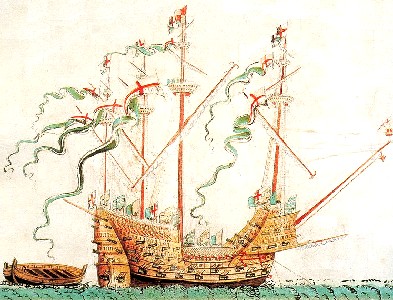
Artist: Anthony Anthony - The Carrack Henry Grace a Dieu (c. 1546)
This indicates that the docks already existed, although it is not clear that they had been built specifically for the navy. Following this period, a variety of other ancient English Kings used the port to assemble their fleets and/or stage attacks on Normandy, Poitou, and Gascony during the medieval period. Being such an important English port, the city was burned by invaders several times, destroying the docks.10
The world's first dry dock was built at Portsmouth under the direction of King Henry VII beginning in 1495. Henry wanted it to disassemble his ship Henry Grace a Dieu so that the the pieces could be salvaged to construct his 600 tun ship Sovereign. The dry dock "was a vast improvement on anything that went before and can be seen as a turning point in the style and methods of ship construction and the way future dockyards would be laid-out and used."11 Jonathan Coad notes that the construction of this dock set two important precents: "Its high cost was to be echoed by its successors - dry docks remained probably the navy's most expensive capital equipment on shore until the advent of nuclear facilities in the latter part of the 20th century. Even more importantly, finding a suitable site for a dry dock determined the location of the whole dockyard."12
 The Encampment of the English Forces Near Portsmouth in 1545, Cowdray engraving (c 1770) |
Portsmouth remained an important port throughout the beginning of the first half of the 16th century because of its protected port and safe anchorage, although its importance waned when Medway was established as the fleet anchorage and a dockyard established at Chatham in 1547.13 The city was primarily a garrison town for soldiers during the late 16th and early 17th

Plan of Portsmouth, British Library, (1545)
centuries, making it highly susceptible to plague outbreaks.14 It again became busy during the Commonwealth (1649-1660), being recommended as the permenant station for the navy, but the Commissioner in charge of the site said in 1652 that this would be difficult to do since the site already lacked sufficient storage space for the ships that were stationed there.15 However, the Dutch conflicts that did not favor the use of Portsmouth during this time and Portsmouth didn't become a strategically relevant navy yard until the English wars began to focus on the French in the late seventeenth century.16
Nevertheless, additional land was purchased several times to expand the naval facilities, including in 1527, 1663 and 1677.17 The piecemeal nature of these additions contributed to an inefficient layout, resulting in sites being scattered all about the property.18 In May of 1720, the Victualling Board wrote to the Admiralty secretary that "the buildings are ...old and the inconveniences ...many ... although we are not as yet capable of proposing ...a remedy thereto"19.
Several fires occurred in the sixteenth century, affecting the storage of supplies and victuals. In 1557, a "great and terrible ffyer" burned the Naval Storehouse on King Street destroying 26,000 cask hoops and 100 tuns of empty casks.19 Most of the dockyard was destroyed in another fire in 1570.20 Six years later, the King Street storehouse was again burned.21 It is likely the wooden structures, the crowding and disorganization of buildings and the nature of supplies stored all contributed to this problem. The oldest recognized building on the site today is the Porter's Lodge, built next to the main gate of the yard in 1708.22 It is notably a brick building covered in stucco, hinting at the lessons learned in the previous centuries.23
The victualling process grew with the navy yard, although the majority of the food supply came from London. Beer and biscuit seem to have been the primary exceptions for most of this period, each being purchased locally via public-private agreements until the beginning of the eighteenth century when the Victualling Board began making changes. Shortly after the completion of the first Portsmouth dry dock in 1496,
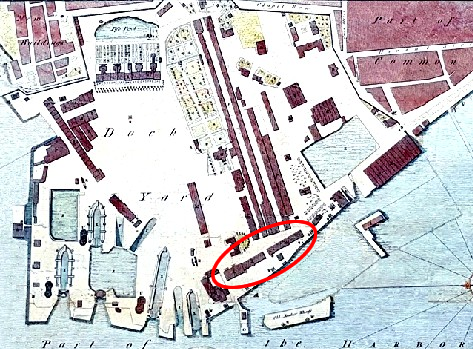
Artist: Thomas Milton
A Geometrical Plan of His Majesty's Dock Yard Near Portsmouth (1754)
Most of the buildings on this plan were either involved in ship building or were offices. The only
building specifically mentioned which may have been involved in victualling were the Storehouses
which are circled in red.
a variety of structures required for victualling the navy appeared. As a result, "brew-houses were built and leased to private individuals on condition that the king should have the use of them in time of war, and in 1525 there were also five royal brew-houses, the 'Rose,' the 'Lion,' the 'Dragon,' the 'White Hart,' and the 'Anchor,' and foreign trade increased."24 These were "to supply the army and navy with ‘a good beverage’ (a gallon per head per day)"25. In addition, a bakehouse was constructed called 'Swanne' which was tasked with supplying biscuit to the navy.26 It is not clear what happened to these structures, although the brewhouses mentioned were repaired in 1589, so they were still around at that time.27
With the beginning of the Nine Year's war in 1688, Portsmouth again became a pivotal port to the English navy, having sufficient storage capacity for victual processing. Yet it was still primarily supplied from London.28 "Few of the townspeople ...seem to have been able to supply any necessaries [to the navy], stores having to be sent from London or bought at Southampton; wood was the only thing obtained plentifully in the neighbourhood."29 In addition to this, the "storeroom was limited, being confined within the garrison, and there was no bakehouse or brewhouse [in the navy yard]."30
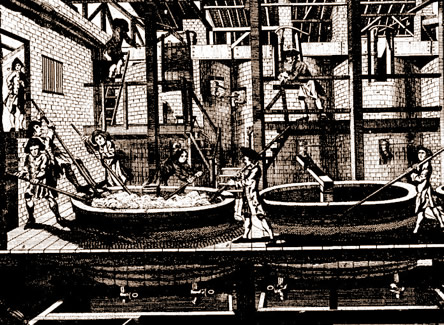
Brew-House, From The Complete Dictionary of Arts and Sciences, Vol 1,
By T.H. Croker, Thomas William & Samuel Clark
(1766)
By 1705, beer was being purchased from three local contractors, an arrangement which remained in place until 1710.31 Some of the biscuit at Portsmouth was supplied by contracted bakehouses in Portsmouth, Southampton, Newport and Gosport with the rest coming either from the Tower in London or other contractors.32
In March of 1707, the Lord Admiral wrote a memorial to the queen which noted the 'great inconveniences' that occured at Plymouth because the government didn't have a baking or brewing facility of their own. This resulted in contracted brewers charging more for their beer - even though it was sometimes so bad it made the sailors ill - and resulted in the navy being unable to quickly get sufficient beer and bread.33 As a result, orders were received to build and bakehouse, brewhouse and cooperage at Plymouth and to buy land near the Entycombe dock in the Hamoaze.
The plan included building a slaughterhouse, a hanging house for hogs, a room for the copper, pens for the hogs, a cuttinghouse, a salt house, a shed with a copper for boiling pickle, two store-houses for beef and pork with an upper storey for dry provisions, a bakehouse with a storey
for biscuit, a room for punching small coal, a cooperage of five shops with one storey for cask, a brewhouse with two coppers, a malt mill and malt room, two storehouses for beer, lodging for the agent, storekeeper, master cooper, clerk of the brewhouse, master brewer and some offices for the clerks. This is interesting as showing the commissioners' idea of what a complete victualling office should contain34.
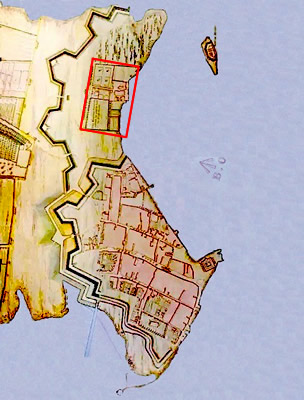
Cartographer: John Peter Desmaretz -
Plan of Gosport (1757)
The Red Box Shows the Area Where the
Weevil
Creek Brewery
Would Have Been Located, Although Exactly Where is Unknown
Unfortunately the cost for this elaborate victualling plan was so high that it never came to fruition. As seemed to be the custom for English naval victualling yards during this period, a a variety of victualling components were constructed piecemeal in the area.
A small slaughterhouse had been built at Portsmouth some time before 1702 which was capable of handling 120 oxen a week. Its primary output was beef; most of the pork used by the navy there came from London or Plymouth. In 1706, the board told Agent Robert Wilkins that they had heard the oxen being sold to the yard were "not so good as they ought to be and... [we] therefore direct him to look narrowly into the receipt of the flesh killed there and take particular care that none be received but what is very good."35
The Victualling Board also established a brewery at Weevil Creek in Gosport on the other side of the harbor where land was cheaper and more readily available in 1714. By 1716, this site also had a cooperage which made barrels for the beer. The Crown rented these facilities from contractors until 1753.36 "The good supply of pure fresh water was soon to earn a fine reputation in English Ales."37
A large bakery was established in King Street in Portsmouth at some time before 1714.38 The English Crown also purchased land at the southwest end of what used to be the mill pond located north of Portsmouth to supply flour to the naval bakeries in the city in 1712.39 Development continued and by the mid-eighteenth century, a storehouse was built on King Street and a grain mill constructed near the Ordnance Yard.40
 Artist: John Clevely the Elder - Portsmouth Navy Yard From Water, From A Geometrical Plan of His Majesty's Dock Yard Near Portsmouth (1754) |
The location was important enough to rate permenant officers who were involved with victualling. A Clerk of Stores was appointed to manage the storehouses for the navy as early as 1542. He would have been responsible for receiving and issuing stores and provisions. By 1660, in addition to the Clerk, Portsmouth had a Victualling Agent by the name of John Shales who would have been responsible for stocking the victual storehouse, arranging contracts for the site and overseeing the clerk. He was likely a contracted victualler. He remained involved with Portsmouth until 1688.41 With the establishment of the Victualling Board 1683, William Brandon became the appointed navy victualling agent with Christopher Godsalve serving as storekeeper.42 Brandon served until at least 1704 and likely to the next year.43
In an effort to reduce theft at the site, the Victualling board appointed a Clerk of the Cheque at Portsmouth in 1710. His job was to be present "at the receiving and issuing all provisions and that for the future the storekeeper be charged with the same but not to receive or issue any part thereof without a warrant signed by the agent."44 In 1710, Robert Wilkins was serving as the victualling agent as he had been since 1705. His storekeeper was William Sloane, who had been in that job since 1702.46 Thomas Hanway was mentioned iun the official records as the Agent between 1711-14.46
1 "175 AD Roman Period", Portsmouth Royal Dockyard Historical Trust, gathered 10/30/20; 2 "897 - Alfred", Portsmouth Royal Dockyard Historical Trust, gathered 10/30/20; 3 'The liberty of Portsmouth and Portsea Island: Introduction', A History of the County of Hampshire: Volume 3, William Page, ed., 1908, pp. 172-192. British History Online, gathered 10/30/20; 4 "1086 - William", Portsmouth Royal Dockyard Historical Trust, gathered 10/30/20; 5 'The liberty of Portsmouth and Portsea Island: Introduction', gathered 10/30/20, "1180 - Foundation of Portsmouth", Portsmouth Royal Dockyard Historical Trust, gathered 10/30/20 & "GISORS, John de (Jean de)", The Portsmouth Encyclopedia, Alan King, ed, 2011, p. 154; 6 'The liberty of Portsmouth and Portsea Island: Introduction', gathered 11/2/2020; 7 Borough Market Privileges: the Hinterland of Medieval London, C.1400. british history online website, Originally published by Centre for Metropolitan History, London, 2006. gathered 11/2/2020;8 'The liberty of Portsmouth and Portsea Island: Introduction', gathered 11/2/2020; 9 "1212- A Royal dockyard is born", Portsmouth Royal Dockyard Historical Trust, gathered 11/2/20; 10 See Dockyard Timeline (Roman -- 1495), Portsmouth Royal Dockyard Historical Trust, gathered 11/2/2020 for more details; 11 "1495 - Worlds First Dry Dock", Portsmouth Royal Dockyard Historical Trust, gathered 11/2/20; 12 Jonathan Coad, Support for the Fleet, 2013, p. 1; 13 Coad, p. 1 & 4; 14 'The liberty of Portsmouth and Portsea Island: Introduction', gathered 11/2/2020; 15 Michael Oppenheim, A History of the Administration of the Royal Navy, Vol 1, 1896, p. 364; 16 Coad, p. 4; 17 "1527 - Dockyard expansion", "1663 - Dockyard expansion". "1677 - Dockyard Expansion", "1687 - Dockyard Funding". Portsmouth Royal Dockyard Historical Trust, gathered 11/2/20; 18 Coad, p. 301; 19 "20. Victualling Board to Admiralty Secretary - 18 May 1720," Naval Administration 1715-1750, Daniel A Baugh, ed., 1977, p. 428; 20 "1557 - Fire in Naval Store House", Portsmouth Royal Dockyard Historical Trust, gathered 11/2/20; 21 "1570 - Dockyard Fire", Portsmouth Royal Dockyard Historical Trust, gathered 11/2/20; 22 "1576 - Storehouse Fire", Portsmouth Royal Dockyard Historical Trust, gathered 11/2/20; 23 "1708 - Building of Porter’s Lodge", Portsmouth Royal Dockyard Historical Trust, gathered 11/2/20; 24 "PORTERS LODGE (BUILDING NUMBER 1/7)", Historic England Website, gathered 11/2/2; 25 'The liberty of Portsmouth and Portsea Island: Introduction', gathered 11/2/2020; 26,27 "1513 - Victualling Built", Portsmouth Royal Dockyard Historical Trust, gathered 11/2/20; 28 Oppenheim, p. 143; 29 John Ehrman, The Navy in the War of William III 1689-1697, 1953, p. 155; 30,31 Paula K. Watson, "The Commission for Victualling the Navy, the Commission for Sick and Wounded Seamen and the Prisoners of War and the Commission for Transport, 1702–1714," University of London PhD thesis, 1965, p. 87; 32 Watson, p. 878; 33 See '26. Memorial from Lord High Admiral to her Majesty in Council. 18th March 1706/7', Queen Anne's Navy, Commander R. D. Merriman, ed.,1961, p. 280; 34 Watson, p. 144-5; 35 Watson, p. 88; 36 Oppenheim, p. 40 & Roger Morriss, The Foundations of British Maritime Ascendancy, Resources, Logisitics and State, 1755-1815, 2011, p. 282; 37 Oppenheim, p. 40; 38 Morriss, p. 282; 39 "1700 - Victualling the Fleet," Historic England Website, gathered 11/2/2; 40 Coad, p. 394; 41 "Capt. John Shales", The Diary of Samuel Pepys website, gathered 11/2/20; 42 His Majesty's Stationery Office, Calendar of Treasury Books, Volume 7, 1681-1685, 1916, p. 968 & 1370; 'William Brandon, Agent for the Victualling at Portsmouth, to Victualling Board, 10th March 1703/4', Cited in Merriman, p. 270; 44 'Adm 7/215', cited in Watson, p. 161; 45 "46. Victualling Board to Secretary of the Admiralty, 4th July 1710," Queen Anne's Navy, Commander R. D. Merriman, ed.,1961, p. 296; 46 Office-Holders in Modern Britain: Vol 7, Navy Board Officials 1660-1870, J. M. Collinge, ed., British History Website, gathered 2/3/21
Victualling at Dover
The Dover victualling location had a long pedigree, being located on the
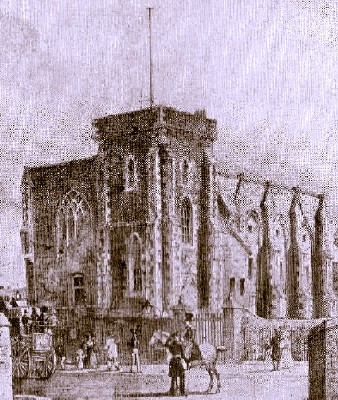
The Maison Dieu in 1833, From Dover, A Perambulation of
the Town,
Port, and Fortress (1907)
former grounds of the Maison Dieu, a hospital run by monks. The order was evicted and the land taken from for national use by order of King Henry the Eighth around 1544.1 "In the reign of Queen Mary [1553-8], the Maison Dieu was converted into a Victualling Office for the Navy, the well-fitted brew house and bakehouse left there by the Master and Brethren answering for Naval purposes."2
Just as the Plymouth location served the western fleet, so Dover served the eastern fleet.3 An undated 17th century memorial document states that Dover was "the greatest storehouse for provisions for his Majesty's navy; and that one of the chief victualling-offices for his fleet was in the town. ...As it was the chief port between Portsmouth and Harwich, its importance to merchants was very great; for their ships, in cases of accidents, and in storms, could put in and refit."4
By the War of Spanish Succession, Dover was one of the best equipped non-London-based sites for victualling, "having a small cooperage, bakehouse and slaughterhouse, but no brewhouse."5 Apparently the brewhouse built in the mid 16th century was gone by this time; the Dover Agent was responsible for negotiating a contract each year with brewer Jeremiah Kelly of Deal for their beer. Even with all of its facilities, it could not meet all the victualling needs during the war, requiring outside support to meet the Navy's requirements.
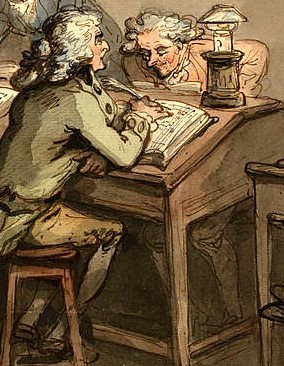
Artist: Thomas Rowlandson
Keeping Accounts, A Merchants Office (1789)
A red brick mansion was constructed on the grounds of the Mason Dieu which served as the residence and office of the Agent Victualler of the Navy in 1665.6 In addition, "there were stores in connection with this Victualling Office, at the Victualling Yard, beside the quay in Strond Street, from whence despatch boats communicated with the fleet in the Downs."7
Edward Wivell was a Victualling Agent at Dover in 1667, a position he served in 'for severall years', although this was likely a contracted merchant-agent position.8 With the establishment of the Victualling Board, Benjamin Hawkes was appointed Victualling Agent on site in 1683 with Jarvis Willey serving as his storekeeper.9 As occurred at Portsmouth, the Victualling board appointed a Clerk of the Cheque at Dover to oversee receipt and issuance of all provisions in an effort to reduce pilfering in 1710.10 The Victualling Board reported in 1710 that this role had been filled by Lancelot Whitehall since May of 1703.11 Official records note that Thomas Colby was the Victualling Agent there in 1711 and James Kirkpricked served in 1721.12
This location continued to serve as a victualling office for the navy until 1831.
1 John Lyon, The history of the town and port of Dover and of Dover Castle, Vol. 1, 1813, p. 49 & 'Maison Dieu', Dover Museum Website, gathered 1/20/20; 2 John Bavington Jones, 'Perambulation Of The Town, Port And Fortress, Part 47', Published in the Dover Express, 4 January, 1980, Dover Kent Archives, gathered 1/20/20; 3 Michael Oppenheim, A History of the Administration of the Royal Navy, Vol 1, 1896, p. 363; 4 Lyon, p. 173-4; 5 Paula K. Watson, "The Commission for Victualling the Navy, the Commission for Sick and Wounded Seamen and the Prisoners of War and the Commission for Transport, 1702–1714," University of London PhD thesis, 1965, p. 91; 6 'Maison Dieu House', www.dover.freeuk.com, gathered 1/28/20; 7 Bavington Jones, 'Perambulation Of The Town, Port And Fortress, Part 47', gathered 1/20/20; 8 Calendar of State Papers, Domestic Series, of the Reign of Charles II, Volume 7, Mary Anne Everett Green, 1866, p. 341 & "Dover, St Marys", Kent Archelogical Website, gathered 2/4/21; 9 His Majesty's Stationery Office, Calendar of Treasury Books, Volume 7, 1681-1685, 1916, p. 968 & 1370; 10 Watson, p. 162; 11 "46. Victualling Board to Secretary of the Admiralty, 4th July 1710," Queen Anne's Navy, Commander R. D. Merriman, ed.,1961, p. 296; 11 Office-Holders in Modern Britain: Vol 7, Navy Board Officials 1660-1870, J. M. Collinge, ed., BHO Website, gathered 2/3/21& Office-Holders in Modern Britain: Vol 4, Admiralty Officials 1660-1870, J. C. Sainty, ed., BHO Website, gathered 2/3/21
Victualling at Plymouth
As already noted, victualling at Plymouth has a long history with supplies coming from Sutton Harbor.

Sutton Poole (Harbor) at Plymouth (1540)
It was primarily used to victual ships with the western squadron.1 The ships sent to combat the Spanish Fleet in 1588 received their food supplies from Plymouth. "The port's role as a victualling station grew substantially
from the middle of the seventeenth century. In the 1650s... new
victualling storehouses were erected at Lambhay in Sutton Harbour. These buildings supplemented those already existing at Coxside."2
During the beginning year of the War of the League of Augsberg, Plymouth was being "considered as an advanced store base in June of 1689, and before the end of that month a storekeeper had been appointed, with instructions-to muster the ships there, as well as to serve stores, 'untill the yard shall be settled, and a Clerk of the Cheque established'3. In September, the assistant surveyor of the navy was ordered "to Dartmouth and Plymouth, and taking notice of all the parts thereunto, to represent what was found most suitable to the design and building one single dry dock"4. He chose the Hamoaze at Plymouth, where a dry dock capable of handling a first rate ship of this period began construction in 1691.5
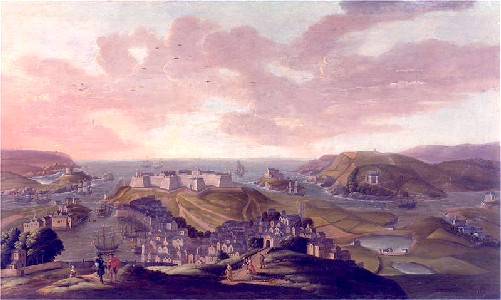
Artist: Hendrik Danckerts - Plymouth, Sutton Harbor is to the Left (1673)
England was fighting against France whose Atlantic bases posed a threat to merchant trade, so the new dock was built with an eye towards protecting those interests. "With the concentration of Britain's main battlefleet in the western approaches, the Royal Plymouth Victualling Yard and Office in Sutton Harbour expanded considerably."6 The need for improvements in the victualling system became apparent because ships coming into the Plymouth Dockyard in 1693 still had to get their provisions by river from a store yard over two miles away.7
Lord High Admiral Prince George wrote Queen Anne in March of 1707 complaining that victualling at Plymouth presented "great inconveniences ...for want of a bakehouse and brewhouse of her Majesty's own at that port"8. He ordered the Commissioners of Victualling, "to prepare ...an estimate of the charge of erecting a bakehouse and brewhouse at Plymouth, with a cooperage, storehouses, and other conveniences necessary"9. He went on to suggest purchasing "a parcel of land on which the said buildings may be conveniently erected" from Richard Edgecumbe.10 As a result, a new Victualling Office opened in Lambhay in 1707 which overseen by an Agent Victualler.
Samuel Langford was mentioned as Victualling Agent at Plymouth in 1667, although this was likely more in a the merchant victualling capacity the navy employed at that time.11 William Addis became the agent under the auspices of the Victualling Board in December of 1683 serving until at least 1700.12 A Clerk of the Cheque the Victualling board appointed at Plymouth to oversee provision issuance and receipt in order to reduce pilfering just as had occurred at Dover and Portsmouth in 1710.13

Artist: Thomas Milton
A Geometrical Plan of His Majesty's Dock Yard Near Plymouth (1754)
A Storage Yard with Several Storehouses & Workshops is in the Center of the Yard, Circled in Red.
The Victualling Board reported in 1710 that John Stucley had served as the Agent Victualler at Plymouth since March of 1705 with Henry Axton as his storekeeper since April of 1702.14
The majority of the biscuit supplied during the War of Spanish Succession came either from four local bakeries who were "incapable of giving any great credit (being generally poor unless thay have extravagant rates for their bread)" or from other contractors who bought bread from various bakeries in the area.15 All of the meat and oatmeal required were purchased in small quantities from a variety of small, private Plymouth contracters. Peas were not purchased locally, coming instead from the Tower site in London. Beer came from seven local brewers and a brewhouse hired by the Victualling Board. The site was very inefficient for the victualling needs it faced, resulting in frequent shortages because of the site's limited storage capacity.16
Like many of the other victualling sites, Plymouth fell into disrepair after the end of the War of Spanish Succession (1702-14). "The site was neither spacious nor easily accessible, vessels over 30 tons having to load 'after half flood'."17 By 1720, the Victualling Board reported to the Admiralty Secretary that repairing the old buildings at Plymouth would be "to as little purpose as the nailing a new board to a rotten post, nor would it be advisable to erect new buildings on the same place, not only from the insufficiency of room for what buildings would be necessary, but from its very inconvenient situation" the wind would push ships that were trying to load away from the victualling yard.18
This is the only dockyard under study from this period which is still around today, operating under the name Her Majesty's Naval Base, Devonport.
1 Michael Oppenheim, A History of the Administration of the Royal Navy, Vol 1, 1896, p. 363; 2 Michael Nix, The Royal William Victualling Yard, 1997, not paginated; 3 John Ehrman, The Navy in the War of William III 1689-1697: Its State and Direction, 1957, p. 416; 4 Jonathan Coad, Support for the Fleet, 2013, p. 3; 5 Ehrman, p. 417; 6 Nix, not paginated; 7 Ehrman, p. 427; 8,9,10 "26. Memorial from Lord High Admiral to her Majesty in Council", Queen Anne's Navy, Commander R. D. Merriman, ed., 1961, p. 280; 11 Her Majesty's Public Record Office, Calendar of State Paper Domestic Series, Charles II, 1667, Mary Anne Everett Green, ed., 1866, p. 174;12 See Calendar of Treasury Books, Volume 7, 1681-1685. Originally published by His Majesty's Stationery Office, London, 1916, p. 968 & 1370 & ADM 106/539/219; 13 Paula K. Watson, "The Commission for Victualling the Navy, the Commission for Sick and Wounded Seamen and the Prisoners of War and the Commission for Transport, 1702–1714," University of London PhD thesis, 1965, p. 162; 14 "46. Victualling Board to Secretary of the Admiralty, 4th July 1710," Queen Anne's Navy, Commander R. D. Merriman, ed.,1961, p. 296; 15 Watson, p. 89; 16 Watson, p. 89-90;17 Roger Morriss, The Foundations of British Maritime Ascendancy: Resources, Logistics and the State, 1755–1815, 2010, p. 284; 18 "18. Victualling Board to Admiralty Secretary - 15 January 1719/20," Naval Administration 1715-1750, Daniel A Baugh, ed., 1977, p. 426
Victualling at Chatham and Sheerness
The growth of the London navy victualling yards was slow; the first evidence of navy supply from the area was the rental of a storehouse for the use of the navy at Chatham in 1509.1 In 1514 storehouses existed at Erith (in the southeastern part of London) and Deptford.2 These were likely used as outports to store ship's supplies and

Artist: Nicholas Pocock - Chatham Dockyard, HMS Royal George on the Medway (1790)
victuals which could be brought to vessels anchored in the Nore - a sandbank at the mouth of the Thames - by the hired tenders. However, Chatham Dockyard wasn't begun until after 1550. "What had probably begun as an informal arrangement in the 1540s was made official policy by the Privy Council in 1550, three years after a storehouse had been hired at Gillingham, marking the establishment of what was to grow into Chatham Dockyard."3
Yet Chatham had few facilities and naval vessels preparing to sail in the area usually got their provisions at the mouth of the Medway directly from London.4 It was run only by a Victualling Agent, who likely served as storekeeper. The first Victualling Agents assigned by the Naval Victualling Board at Chatham was Rowland Crisp who began in December of 1683 and still there as late as 1694.5 The Victualling Board noted in 1710 that John Shales had served in this role there since February of 1709.6
By the War of Spanish Succession, Chatham had a slaughterhouse with ten butchers and four salters, although most of the beef produced was fresh, being sent to navy ships in the harbor when the sailors to meet their fresh petty warrent victualling requirements (those consumed by the navy while their ship was at anchor). A small amount of biscuit-baking occurred there, but this was again inadequate for naval sea supply. Most of the naval victuals supplied from Chatham came from London or were purchased by the local Victualling Agent.7
In 1718 the Victualling Board wrote the Admiralty Secretary that it was in "no way advisable to moulder away any more money in endeavouring to patch up and support such old buildings [at Chatham] as would be ready to fall to pieces almost as
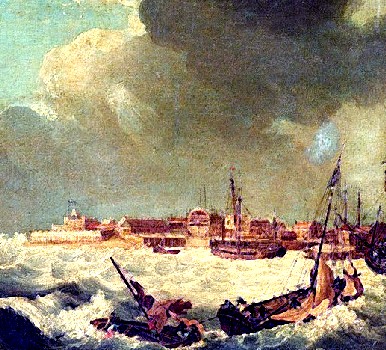
Sheerness Dockyard in a Storm, Royal Museums Greenwich, (c. 1750)
soon as the work was done... rather an entire victualling office with proper conveniences should be erected on that ground, or ...in some other place that may be found out for that purpose"8. In 1720 it was again stated that Chatham yard needed to be reviewed because its structures were old and the layout was inconvenient.9
By 1749, Chatham served only as storage yard for petty warrant victuals provided to ships being repaired along with the port's guard ships.10 It was gradually supplanted by a dockyard at nearby Sheerness, which was much more conveniently located for supplying ships at the Nore. Sailing to Chatham required a ship to enter the river, the passage for which was difficult for "a large sailing ship relying on favourable winds and tides [and] might require days rather than hours. A similar problem existed for ships at the yards when they were ordered to put to sea."11
In Spring, 1665, a small ready-to-use storehouse was erected adjacent to the foreshore near the Sheerness Point while the navy officials pondered what form the final dockyard should take. Here, 're-victualling' of navy ships occurred, with the food coming from Chatham or Queensborough.12 Plans for a dockyard were made; Samuel Pepys explained in his diary on August 18, 1665 that he went "to Sheernesse, where we walked up and down, laying out the ground to be taken in for a yard to lay provisions for cleaning and repairing of ships, and a most proper place it is for the purpose."13 Work rebuilding the fort and dockyard began in 1667 primarily because "access to Chatham, Deptford and Woolwich dockyards hazardous and the source of numerous accidents."14
However, victual do not appear to have been stored at Sheerness on land during this period. In February of 1694,
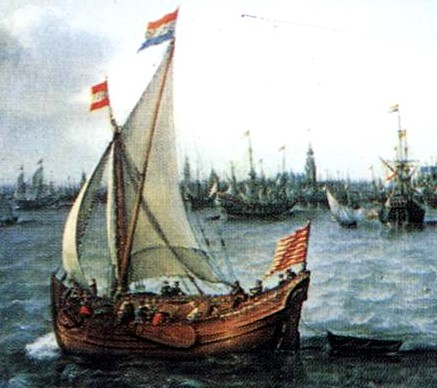
Artist: Hendrick Cornelisz - Flyboat or Vlieboot, The Harbour in Amsterdam (1630)
the Navy Board reported to the Admiralty that "there is no place about Sheerness proper for the accommodation of victuals, and ...it would not be worth the while to be at the charge of erecting storehouses and [placing] officers there for this service ...since their Majesties' ships in those parts may always be timely supplied from London or Chatham, as formerly,
(but especially from Chatham) if due care be taken therein."15 Chatham Victualling Agent Rowland Crisp wrote the Victualling Board, suggesting that "it will be far more convenient [to store victuals at Sheerness] afloat than on shore" in flyboats. In addition, he noted that "the ground [at Sheerness] is all marshy and watery, so that to have thoughts to build any storehouses there it will require not only a great deal of time but a great deal of money before there can be a good foundation made for the erecting any buildings."16
In fact, the Board had already suggested that four large flyboats [vlieboots - cargo ships] be located off Sheerness "the two biggest to be stile [sic] laden with beer, a third, a receptacle for beef and pork, and the fourth for dry provisions."17. From this suggestion, an order was given to station such a vessel there to provide 'wet' provisions (beef and pork, which were stored in pickle). As the Board explained, moving beer often resulted in the casks leaking as well as being inconvenient and expensive to do. Why a boat for dry goods was not ordered isn't indicated. Sheerness remained in operation as a naval base until 1960.
1 The Naval Dockyards Society, 20th Century Naval Dockyards: Devonport And Portsmouth Characterisation Report, 2012, p. 2; 2 Michael Oppenheim, A History of the Administration of the Royal Navy, Vol 1, 1896, p. 83; 3 Jonathan Coad, Support for the Fleet, 2013, p. 2; 4 Roger Morriss, The Foundations of British Maritime Ascendancy: Resources, Logistics and the State, 1755–1815, 2010, p. 283; 5 See "No. 115 From Mr Rowland Crisp, Agent, to the Commissioners of the Victualling, Dated at Chatham Victualling Office, February II, 1693/4", Sergison Papers, p. 240 & Calendar of Treasury Books, Volume 7, 1681-1685. Originally published by His Majesty's Stationery Office, London, 1916, pp. 968 & 1370; 6 "46. Victualling Board to Secretary of the Admiralty, 4th July 1710," Queen Anne's Navy, Commander R. D. Merriman, ed.,1961, p. 296; 7 Paula K. Watson, "The Commission for Victualling the Navy, the Commission for Sick and Wounded Seamen and the Prisoners of War and the Commission for Transport, 1702–1714," University of London PhD thesis, 1965, p. 92; 8 "14. Victualling Board to Admiralty Secretary, 30 July 1718," Naval Administration 1715-1750, Daniel A Baugh, ed., 1977, p. 422; 9 "20. Victualling Board to Admiralty Secretary - 18 May 1720," Naval Administration 1715-1750, Daniel A Baugh, ed., 1977, p. 428; 10 Coad, p. 302; 11 David T Hughes, Sheerness Naval Dockyard and Garrison, 2006, p. 7; 12 'A short history of Sheerness', Adapted from Sheerness Naval Dockyard & Garrison by David T. Hughes, thehistorypress.co.uk, gathered 1/19/20; 13 Samuel Pepys, The Diary of Samuel Pepys, August 18th, 1665 entry; 14 Trevor M. Harris, “Government And Urban Development In Kent: The Case Of The Royal Naval Dockyard Town Of Sheerness”, Archaeologia Cantiana, Vol. 101, 1984, p. 248; 15,18 "No. 114 Navy Board to Admiralty - February 7, 1693/94", The Sergison Papers, (Naval Clerk of Acts), R.D. Merriman, ed., 1950, p. 240; 17 "No. 115 From Mr Rowland Crisp, Agent, to the Commissioners of the Victualling, Dated at Chatham Victualling Office, February II, 1693/4", Sergison Papers, p. 240; 18 "No. 114 Navy Board to Admiralty - February 7, 1693/94", Sergison Papers, p. 240
Victualling at Harwich
About fifty miles from Chatham is Harwich on the River Orwell, which first appears in English naval history as a gathering point for King Edward III's navy in 1338.1 In 1565 the Marine Council noted that Chatham had a deep enough harbor in which "any ship may come in and enter at a low water and diverse times the ships of foreign
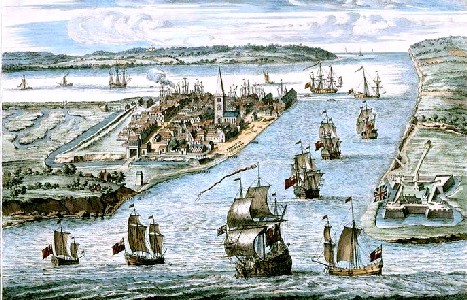
A Prospect of the town and Harbour of Harwich, (1750s)
parts are driven to lie before the town for extremity of weather, sometimes of necessity of victuals and many times to make sale of such merchandise as they have in freight."2 Yet, until the seventeenth century, the navy only used Harwich occasionally.3
The navy's commitment to Harwich began in a small dockyard established around 1654 during the second Dutch War under the 'energetic direction' of Navy Board Commissioner Nehemiah Bourne.4 However, "this Yard in 1667 was laid aside, only the Store-keeper was continued to take Care
of his Majesty's Concerns left there"5. Like Chatham, "Harwich was to be supplemented and rapidly eclipsed by a new dockyard begun in 1665 at Sheerness at the mouth of the Medway."6 Yet it was still kept as a naval victualling point after that time. Navy Chaplain Henry Teonge mentioned that "Boats come to bring us in provision and beer" while HMS Bristol, the ship he was aboard in 1678, was anchored off Harwich.7
"Continued use of Sheerness following the conclusion of hostilities effectively ended Harwich's life as a working dockyard although it did continue as a cruiser station for some time after."8 Cruisers were independent vessels used by the navy and were generally smaller and faster than the English warships. A local slaughterhouse was hired to provide meat at some point before 1705, but it was replaced in November of 1706 by a new contract with a butcher in Ipswich.9 From at least 1706 to 1710, Edmund Allen was the Victualling Agent there.10 The Harwich dockyard was officially closed in 1713, although naval ships still continued to use the area during wars.
1 Graham Stewart, Time and Tide - The History of Harwich Haven Authority, 2013, p. 21; 2 Stewart, p. 23; 3 Stewart, p. 32; 4 Jonathan Coad, Support for the Fleet, 2013, p. 2; 5 Samuel Dale, The History and Antiquities of Harwich and Dovercourt, 1730, p. 238; 6 Coad, p. 2; 7 Henry Teonge, The Diary of Henry Teonge, Chaplain on Board H.M.’s Ships Assistance, Bristol, and Royal Oak, 1675-1679, 1825, p. 238; 8 Trevor M. Harris, “Government And Urban Development In Kent: The Case Of The Royal Naval Dockyard Town Of Sheerness”, Archaeologia Cantiana, Vol. 101, 1984, p. 250; 9 Paula K. Watson, "The Commission for Victualling the Navy, the Commission for Sick and Wounded Seamen and the Prisoners of War and the Commission for Transport, 1702–1714," University of London PhD thesis, 1965, p. 92;10 "46. Victualling Board to Secretary of the Admiralty, 4th July 1710," Queen Anne's Navy, Commander R. D. Merriman, ed.,1961, p. 296 & Watson, p. 93
Victualling at Deptford
Deptford served as a ship-building location as early as the beginning of the fifteenth century. Henry VIII built a dry dock and storehouse here in 1513 with the yard eventually becoming the most important of all the Royal Dockyards during that period.
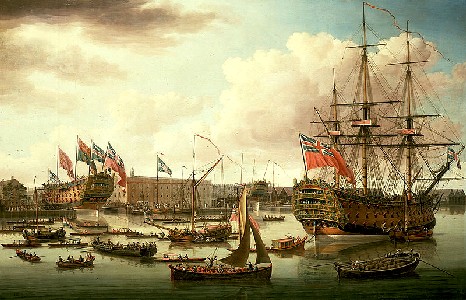
Artist: John Cleveley the Elder
The Royal George in Dock at Deptford Yard & The Launch of The Cambridge (1757)
It was expanded several times during the 16th and 17th centuries and more storehouses were rented to support the dockyard.1 Not long after the purchase of the Tower Hill location in London, the Victualling department began to expand their provisioning facilities. In February of 1650 a slaughterhouse at Deptford originally used by Greenwich Palace (one of the royal residences) was taken for use by the state.2 As a result of the increased need for victualling, contractor Henry Gunden leased the site of an old red brick building which had burned down adjacent to the slaughterhouse in 1665.3 By 1672 he had re-built the structure, setting up a new victualling yard which was much less expensive to run.4 "By the end of the seventeenth century, it contained more storehouses, several slipways [boat launching ramps], new mastponds [a pond used to keep masts submerged so they didn't dry out], cranes, smiths, saw houses and many other facilities."5
Development of the yard continued throughout the eighteenth century. The property was used for victualling navy vessels during the whole of the golden age of piracy. The property lease was eventually acquired by the Victualling Commissioners, resulting in the Navy Victualling Office being relocated there from Tower Hill in 1742.6 This victualling yard continued to serve the navy until it was closed in 1961.
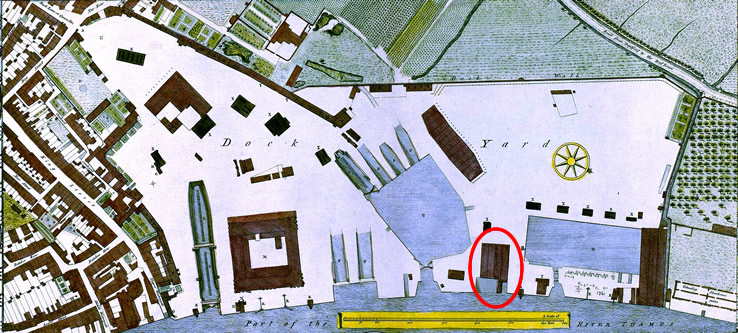 Artist: Thomas Milton - A Geometrical Plan of His Majesty's Dock Yard Near Deptford (1754) Most of the Yard Seems to be Devoted to Working on Ships. A Storage Facility Where Victuals Were Likely Stored is Shown Circled in Red |
1 Charles E. Orser, Jr, Encyclopedia of Historical Archeology, p. 148; 2 Michael Oppenheim, A History of the Administration of the Royal Navy, Vol 1, 1896, p. 325; 23 'Plans of the 'Red House', Deptford', The National Archives, nationalarchives.uk.gov, gathered 1/26/19; 4 J. D. Davies, Pepys's Navy, 2008, p. 200; 5 Orser, p. 148; 6 'Victualling Yard, Deptford', londonremembers.com, gathered 1/21/20 & 'HM Victualling Yard, Deptford', Wikipedia.com, gathered 1/21/20

